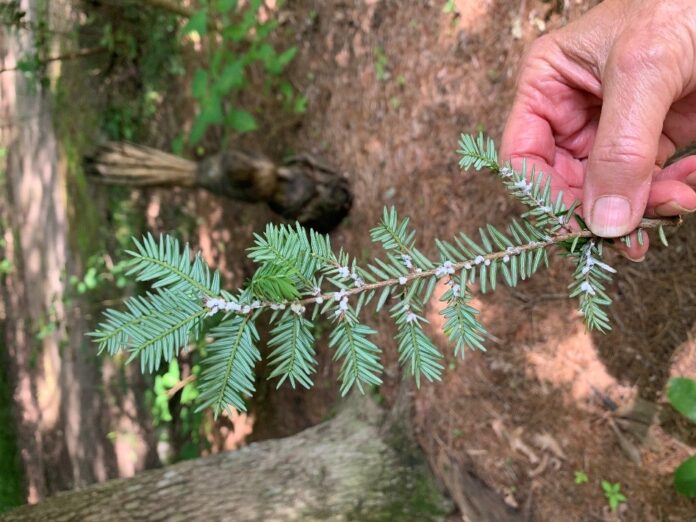Welcome to “Naturally Alabama!” For a while now I have desired to write a series of articles based on what I have encountered in almost 40 years of working in the forest. What you will receive by reading this article is some research-based information balanced with some homespun common sense. I trust you will enjoy these articles as much as I have enjoyed personally encountering the subjects.
I love working in the woods! I love the peace and symmetry found in the forest. My wife and I live in a little crosstie cabin tucked into the big woods of the Talladega Mountains. When life, office work, or U.S. 280 traffic gets too overwhelming I go to the woods. Everything functions so smoothly and slows down in the woods. In the woods I can see equilibrium, pattern- and symmetry is found at every turn. Look at the Fibonacci spiral of a pine cone, sunflower or hurricane; they are beautiful. Pull back the leaf litter/pine duff, grab a magnifying glass and lay on your belly; it is absolutely amazing what goes on under the litter with those tiny creatures.
My favorite amazement is pollen. Green plants are rooted to the ground. They cannot move as animals do. Most plants pollinate to reproduce. While most of our cultivated plants use pollinators to accomplish reproduction, most of our trees use the wind.
Imagine this: in the spring while your car has turned yellow, the trees in our neighborhoods are cascading the environment in that shower of pollen. Male flowers, the stamen, on oaks, pines, sweetgums and other trees are all releasing their pollen together to impregnate the female flowers, the pistil, on adjacent trees to produce a seed. This seed becomes the next generation of tree or food for another creature. Each year each large tree can produce roughly 20,000 seeds. What amazes me about pollination is that with all the pollen flying around, why don’t we find oak-pine trees or pine-sweetgum trees? Interesting.
Sometimes the serenity gets disrupted. Non-native invasives, whether plants, animals, insects or pathogens are causing great harm to our forests.
Last month, the beginning of June, another invasive, an imported danger, was found in Alabama. This invasive is called Hemlock woolly adelgid (HWA) (Adelges tsugae). HWA was found in the small community of Mentone on top of Lookout Mountain. It had been in adjacent counties in Georgia and Tennessee for a decade before entering Alabama. Found around Richmond, Virginia in 1951, this invasive from Japan has slowly moved throughout the eastern U.S., decimating forests of eastern hemlock (Tsuga canadensis) and Carolina hemlock (Tsuga caroliniana). Many of you have seen the dead hemlocks in the Great Smokies over the last 15 years. My first encounter with HWA was while living in Buffalo, NY in the 1990s. In 1993, it was in the NYC and Catskills areas. A couple of years ago it reached Buffalo.
While eastern hemlock is not an important commercial species in Alabama, it is a very important species environmentally. Eastern hemlock is our only shade-tolerant conifer. It grows in pure stands as well as underneath the canopy of hardwoods. Also, many homeowners grow them as an ornamental in their yards. (Please don’t plant hemlocks in your yard. We may unknowingly bring the adelgid here on nursery stock).
Most importantly, as a forester, I am concerned about the potential loss of the tree because of the shade it gives to our creeks and streams. Many amphibians, fish and macro invertebrates depend on cool water to survive. Without hemlock to shade these waters, especially in the Bankhead National Forrest, many of these critters will die.
One benefit for us in Northwest Alabama is distance. There is an 80-mile gap in the native eastern hemlock range map between “us” and the trees in Mentone. We have native hemlock in Cullman, Colbert, Fayette, Franklin, Jefferson, Lawrence, Marion, Walker and Winston counties. If we can discourage our neighbors from planting hemlock in their yards, and educate those who already have them on how to detect and control the adelgid, we may spare our native hemlocks.
If you have questions about your “yard” hemlocks, give me a call or send me a picture via email. HWA can be seen through magnification and it can be controlled through insecticides.
Blessings. – Andy
“Naturally Alabama” is written by Certified Forester Andrew J. Baril of the Alabama Cooperative Extension System (Alabama A&M University and Auburn University), an equal opportunity educator and employer. Everyone is welcome. Email questions to Andy at ajb0012@auburn.edu or call 205-221-3392. Learn more about what is happening with Extension by visiting the ACES website & social media: www.aces.edu, https://twitter.com/acesedu, www.facebook.com/alabamacooperativeextensionsystem.




























